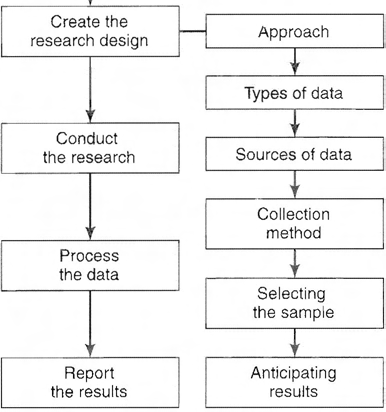CHAPTER 3
IViARKETING RESEARCH: AN AID TO DECISION
3. Research on products-new
research, product features, brand image, con-
cept tests, product tests, and market tests. (See the following Newsline. )
4. Research on advertising and promotion-promotion concepts, copy research, media research, merch andising. packaging, adve;tisin g effectiveness measurement.
5. Research on corporate growth and development--econorrUc and technological forecasting, corporate planning inputs, corporate image, profitability measurement,
merger and acquisition
and facilities location.
NEWSLINE: HOW EXECS USE RESEARCH
Creating and introducing new products is the most important
research priority among marketing executives. The Marketing Science
Institu te of Cambridge, Massachusetts, surveyed 160 executives from
its sponsoring organizations. The executives, representing 60 major
consumer and industrial goods and services corporations , were asked
to divide 100 points among several research areas.
After successful new product introductions, the executives said
that market orientation and customer relationships are the next most
important areas . Those issues displaced improving the use of market-
ing information and measuring brand eqUity as the second- and
third-highest concerns, respectively, in the previous survey.
"The new r esearch priorities indicate that a shift is taking place in
marketing practice," notes Donald Lehmann, executive director of the
institute. "Market orientation has taken hold and the increasing
power of the consumer is apparent in the movement away from prod-
uct-driven strategies. Marketers also realize that they need to make
choices about who their customers should be and whose needs they
are best eqUipped to meet ... and most significantly, they are looking
for better ways to anticipate adoption and diffusion of really new
products." Said Marni Clippenger, communications director at MSI,
"Companies seem to be shifting away from u s i n g the brand to really
figuring out what customers want."
Source: Rachel Rosenthal. "New Products Reign as Research Priority," Adver-
tising Age, August 8. 1994, p . 26; Robert McMath , 'To Test or Not To Test ,"
American Demographics, June 1998, p. 64; John McManus, "Mission Invisi-
ble," American Demographics, Marcb 1999, p. 6.
MARKETING CAPSULE
•
1. Markcting research is the sc ientific and cont(Qlled gath-
2. Any business that is consumer-oriented will benefit from
ering of nonroutine marketing information undertaken to
marketing research.
help management solve marketing problems.
3. Research can be applied to every facet of marketing.
PROCEDURES ANDTECHNIOUES IN MARKETING RESEARCH
57
Sales forecasts
Demographic trends
Cost forecasts
Legislative impact
Product testing
Price testing
Consumer needs
Marketing communication testing
Consumer attitudes
Channel locations
Consumer product usage
Competition
Market size/trends
Psychographic trends
Product replacement
Environmental trends
FIGURE 3.2
Areas of research application
PROCEDURES AND TECHNIQUES
IN MARKETING RESEARCH
Considering the relatively short span of time in which marketing research has developed
since the 1930s, it is quite remarkable that so sophisticated and thorough a collection of
procedures and techniques should have been developed. In many respects, marketing research
has advanced faster than any other specialized area in marketing management. In view of
the highly specialized nature of marketing research, it is not possible in this discussion to
present more than an outline of the basic procedures and techniques .
It is important for a marketing manager to be familiar with the basic procedures and
techniques of marketing research. It is true that many businesspeople will never have occa-
sion to engage personally in marketing research. However, it is quite likely that they will
be faced with a need either to supervise an internal marketing research activity or to work
with an outside marketing research firm. The manager who understands the research func-
tion is in a position to judge intelligently the proposals made by research specialists and to
evaluate their findings and recommendations. Occasionally, the manager herself will have
to seek solutions to marketing problems. It may not be possible to obtain the services of
marketing research specialists. The manager familiar with the basic procedures of fact-find-
ing in marketing should be able to supervise a reasonably satisfactory search for the infor-
mation required.
There is no single set of steps in a market research procedure that is accepted by all.
Indeed, each marketing research problem requ ires, to some degree, its own peculiar pro-
cedure. However, there is general agreement that four major activities should be performed
in a thorough marketing research project. These are: (1) making a preliminary investiga-
tion; (2) creating the research design; (3) conducting the investigation ; and (4) processing
the data/reporting results (see Figure 3.3) 2
Making a Preli minary Investigation
There are two phases of activity in the preliminary investigation. The first of these involves
the determination of the purpose and scope of the research. The second involves an inves-
tigation into the marketing environment called the informal assessment.
Determining the Purpose and Scope o f the Research
The basic and critical problem in marketing research is seldom the problem that appears
on the surface. It is therefore necessary to explore beneath the surface to ascertain the nature and size of the problem. This is the vital first step and must be done correctly, since every subsequent phase of the project is directed at solving the basic problem. For the research




58







